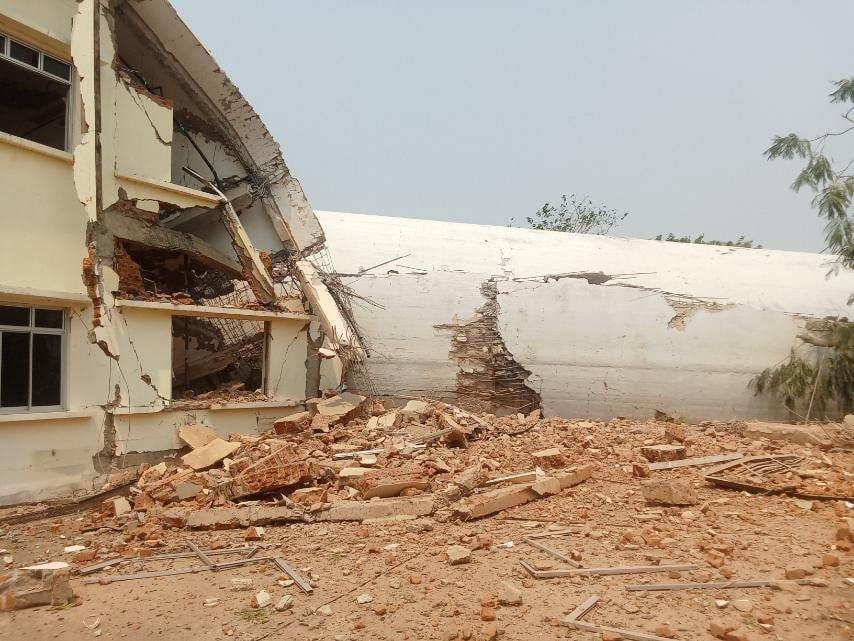Disaster Strikes Myanmar and Thailand: Ceasefires, Collapsed Cities, and a Race Against Time
Reported damage at Naypyitaw International Airport
Executive Summary
A 7.7 magnitude earthquake has devastated Myanmar and Thailand, killing over 1,600 in Myanmar and at least 18 in Thailand. In response, Myanmar’s shadow government has declared a partial ceasefire to facilitate aid, while international support flows into a country already fractured by civil war, environmental exploitation, and geopolitical rivalries.
Analysis
The quake struck near Mandalay on March 28, triggering deadly aftershocks and collapsing buildings across central Myanmar and northern Thailand. Bangkok was hit hard, with a high-rise under construction near the Chatuchak market crumbling and burying workers. Search and rescue efforts continue amid faint hope, with over 80 people still unaccounted for in the Thai capital.
Myanmar has borne the brunt of the disaster. With confirmed deaths surpassing 1,600 and more than 3,400 injured, the country’s response has been strained by both physical destruction and political instability. Entire city blocks in Naypyitaw and Mandalay have collapsed, roads have buckled, and the air traffic control tower at Naypyitaw International Airport was reduced to rubble, limiting the delivery of foreign aid.
The earthquake struck a nation already fractured by years of civil war. Since the military coup in 2021, Myanmar has been gripped by fighting between the junta and the National Unity Government (NUG), a civilian-led resistance movement. In an unprecedented move, the NUG announced a two-week unilateral ceasefire to facilitate earthquake relief. Their armed wing, the People’s Defense Force, will stand down in affected areas while coordinating with the UN and NGOs to deliver aid.
But the junta has not reciprocated. Military airstrikes continued in Karenni and Shan states, even as aid convoys moved toward disaster zones. The military’s history of obstructing humanitarian efforts and weaponizing aid distribution casts a long shadow over recovery. Relief agencies face a logistical nightmare, as hospitals are overwhelmed and medical supplies—including trauma kits, blood bags, and anesthetics—are in critically short supply.
The international community has responded swiftly. China, Russia, India, Malaysia, South Korea, and Singapore have all sent rescue teams and supplies. China alone has pledged nearly $14 million in aid, sent 135 personnel, and deployed drones and detectors. The U.S. has expressed willingness to help, but as of now, is in standby mode.
Yet behind the surge of humanitarianism lies strategic calculation. China’s interest in Myanmar is deeply rooted in the China-Myanmar Economic Corridor (CMEC), a Belt and Road Initiative meant to connect landlocked Yunnan to the Indian Ocean. Myanmar’s instability threatens Beijing’s regional ambitions, especially as resistance forces control much of the territory through which CMEC infrastructure must pass.
Myanmar’s resource wealth further complicates recovery. The country has become a key global supplier of rare earths—metals crucial for electric vehicles and renewable energy. But the environmental cost is devastating: poisoned rivers, deforested mountains, and entire ecosystems reduced to sacrifice zones. Much of the mining occurs in lawless areas controlled by militias, some linked to the junta. The influx of Chinese miners and lack of regulation mean these regions are exploited for profit with little regard for safety or sustainability.
Myanmar now stands at a crossroads: its people reeling from catastrophe, its leaders divided by war, and its fate entangled in regional power plays. While the ceasefire offers a temporary window for relief, long-term recovery will require more than food, tents, and medicine—it will demand political reconciliation, international accountability, and sustainable development.
